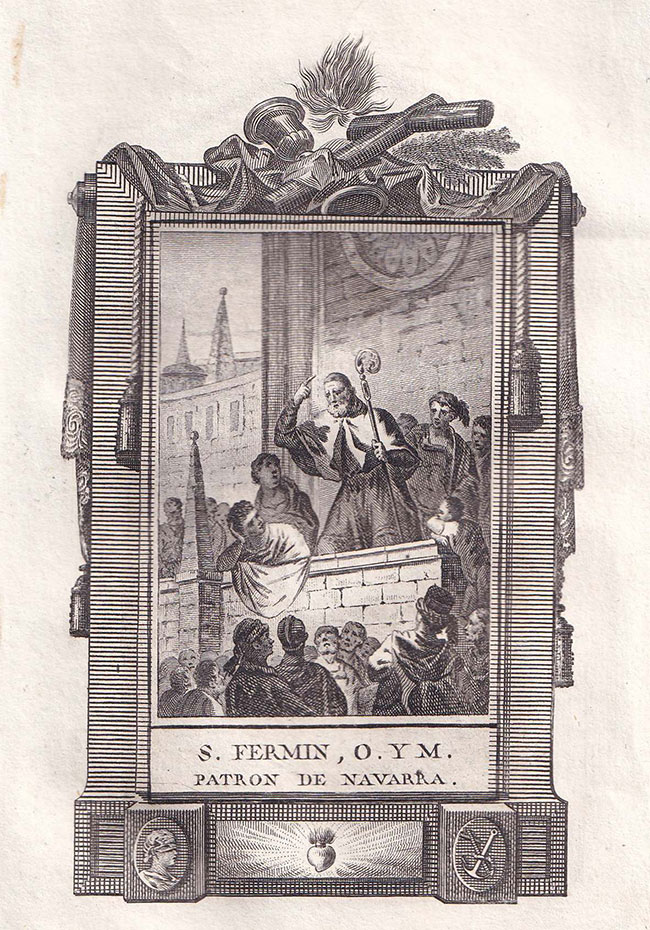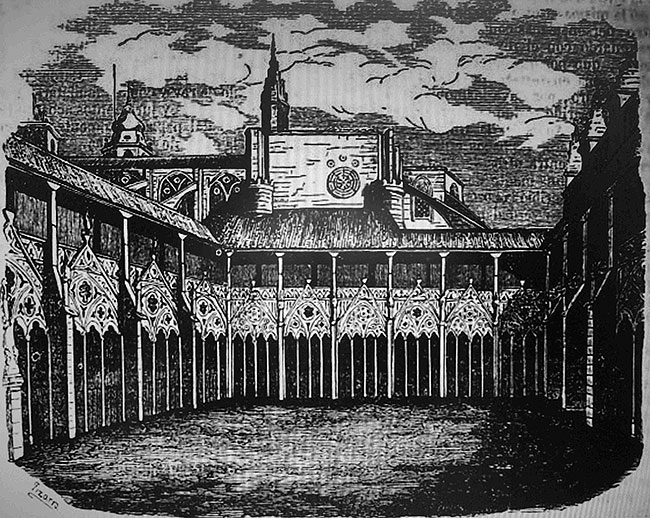The piece of the month of April 2024
ANOTHER ICONOGRAPHY OF SAINT FERMIN: THE SAINT PREACHING IN THE CLOISTER OF THE CATHEDRAL OF PAMPLONA
Emilio Quintanilla Martínez
This singular iconography appears in a print (18.2 x cm the sheet; 13 x the image) of the middle of the XIX century in which we see the saint standing, in declamatory attitude, holding with the right hand a crosier and raising the index of the raised right hand, pointing upwards in an expressive gesture. Of mature age, with a short white beard, he covers his head with a tight hood and wears a talar costume tight to the waist and over his shoulders a kind of muceta open in front or a slavery like that of the pilgrims. He preaches in a terrace that has as background a wall between strong pillars, of which we only see the one on the right, in whose superior part a rosette of not very complicated design opens. In the wall of the terrace there is a small pillar that supports a slender pyramid topped with a small ball. In the background is a building with a row of windows, another pyramid like that of the pillar of the terrace and a small building of apparently central plan with the same subject of pyramid as a top.

Stamp with the Preaching of Saint Fermin in the cloister of the cathedral of Pamplona.
Around the saint are grouped various characters who listen to him with different Degrees of attention. On the terrace, we highlight one with a breastplate and feathers on his head that surely wants to represent a Roman soldier, and another, very young and attentive to the preaching, who leans on the wall and holds his head on one hand, letting his cloak fall on the wall and bringing a point of baroque to the whole, reinforcing a compositional diagonal. In the lower part, Saint Fermin is attended by several figures wearing headdresses and dresses reminiscent of the civil fashion of the end of the age average.
Below, the identifying registration :
S. [AN] FERMÍN, O. [BISPO] Y M. [ÁRTIR].
patron saint OF NAVARRA.
The scene is framed in a manner identical to that of other scenes from the lives of saints, probably all belonging to the same book, a Flos Sanctorum or compendium of the lives of multiple saints that can be found loose in the antiques market. That is why the frame, like an altar cloth, can be used for anyone, because it does not contain singular attributes. In what we could call the bench, the theological virtues: in the center Charity, represented by a flaming heart, to her right Faith, as a female bust of profile blindfolded, and to her left Hope, an anchor crossed on a cross. In the upper part, several symbolic figures of the Church: a chalice, a cross, some flames and an olive branch, all wrapped in fabrics that fall on the sides with tassels that try to solemnize the whole and bring it closer to what we could call a late classicist baroque.
What has caught our attention is not the scene, since the Preaching of Saint Fermin can be found in the cathedral of Amiens or in its chapel in Pamplona, but the place where it takes place, which could be the cathedral of Pamplona itself, and specifically the south wall of the transept, which faces the cloister. That space, suggestively anachronistic, is evoked by the height of the wall, which speaks of a building of importance, and especially the rose window and the framing between strong pillars, somehow similar to the real ones. Moreover, if the author knew the cathedral in situ, he might have been impressed by the pinnacle that crowns the staircase leading to the roofs, those of the Barbazana chapel, and especially by the slender pyramids, totally unornamented, of the cloister kitchen. And that is why he sowed his composition with pyramids.
On the other hand, he may also have been inspired by the engraving that illustrates the 1852 reprint of Father Mariana's History of Spain, by the engraver Ildefonso Civera, very close in time.

Engraving by Ildefonso Civera in Father Mariana's History of Spain, 1852.
